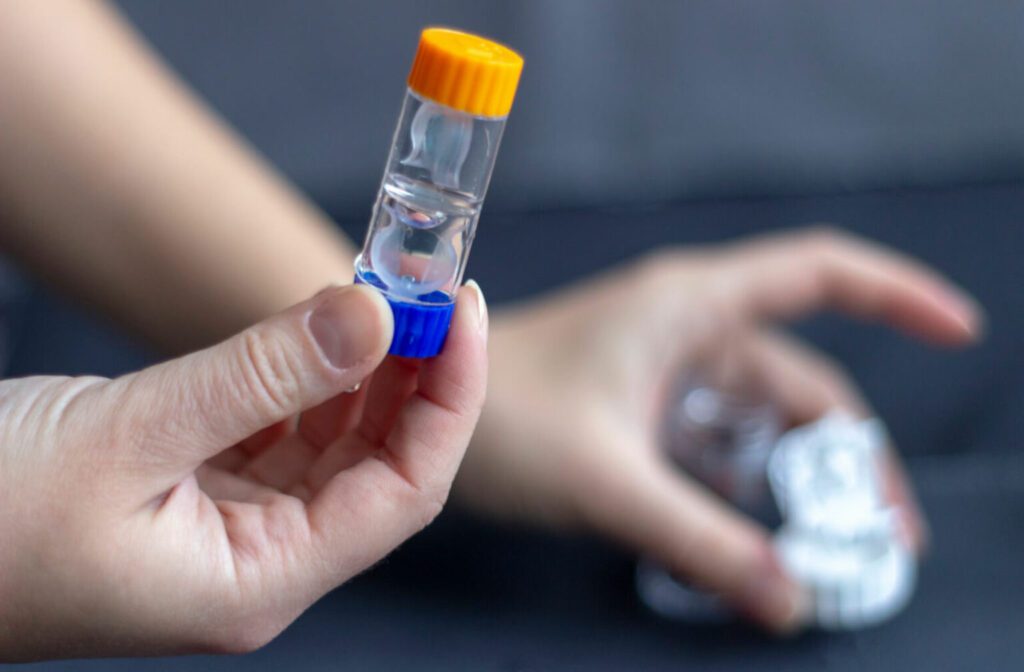Table of Contents

Introduction
As one of California’s leaders in myopia control, we deeply understand how it affects your child’s vision and the strategies available for managing it. Among these strategies are MiSight 1-Day contact lenses and orthokeratology lenses, some of the most popular ways to control myopia development in children and preserve their vision.
But what are these strategies? Is there a difference? Today, we will discuss these 2 techniques and why we might recommend them for managing myopia development.
Of course, the only way to know which myopia control strategy is right for your child is to bring them to a Golden Vision practice for an appointment. During their visit, we comprehensively look at their unique eye care needs and develop personalized plans for helping them achieve the vision they deserve.
Myopia Basics
Before we break down the differences between MiSight and orthokeratology contact lenses, let’s look at myopia and why it’s important to manage.
Myopia, also known as nearsightedness, is a refractive error occurring when the eye elongates, or the cornea becomes too steep. As a result, light entering the eye focuses on the retina instead of on it, causing blurry vision when trying to see far distances.
Children with myopia may find it difficult to participate in activities that use their distance vision, affecting their ability to play sports, watch television, view presentations, and read from school boards.
It is one of the most common refractive errors in the world, and researchers believe that it will affect nearly half of the planet’s population by 2050.
How Does It Develop?
Myopia typically develops in school-aged children, and the risk of it developing increases when there is a family history of the condition or if the child spends too much time doing up-close tasks.
Why Is It Important to Manage?
Without management techniques, myopia may increase the risk of developing several other conditions and concerns, including:
- Glaucoma
- Cataracts
- Myopic macular degeneration
- Retinal detachment
In severe cases, high myopia may contribute to permanent vision loss. Management techniques, like MiSight and orthokeratology contact lenses, can help manage this risk and preserve your child’s sight as they grow older.

What Are MiSight Contact Lenses?
MiSight 1-day contact lenses use myopic defocusing to help slow down myopia. Built into the lens are zones that focus light on the retina and zones that focus peripheral light just in front of the retina.
By focusing peripheral light in front of the retina, researchers found that MiSight 1-day lenses send a signal to the eye that slows down myopia progression. One study found that MiSight contact lenses slow myopia progression by up to 52% compared to traditional contact lenses.
What Are Ortho-K Contact Lenses?
Orthokeratology, or ortho-K contact lenses, use a different technique when compared to other myopia control strategies. Still, studies have shown it to be quite effective in slowing down myopia progression.
Ortho-K contact lenses are rigid gas-permeable lenses worn at night. The lenses gently reshape your child’s cornea as they sleep, correcting their refractive error.
When they wake up, your child can remove the lenses and enjoy temporary clear vision without the need for eyeglasses or contacts. However, your child must continue wearing their ortho-K lenses while they sleep for the treatment to be effective.
According to clinical trials, ortho-K contact lenses have been shown to reduce myopia progression by up to 56% compared to traditional prescription lenses.
Which One Is Right for Your Child?
Now let’s look at which lens might be a better option for your child. Before we can recommend either strategy, we must thoroughly examine your child’s eyes while considering their lifestyle and environment.
In some cases, we might recommend a different strategy than either MiSight or ortho-K, but this ultimately depends on your child and their needs.
MiSight Contact Lenses
MiSight contact lenses may be an option for children with low myopia prescriptions. Because these lenses are disposed of daily, the risk of developing an infection is reduced.
These lenses are made from soft contact lens materials, which make them more comfortable than rigid gas-permeable lenses. However, MiSight contacts typically come in one size, so we have to ensure the lenses fit so they can help manage your child’s myopia development properly.
Ortho-K
Ortho-K contact lenses are typically used to help slow down low to moderate myopia progression up to -6.00D.
Due to its rigid gas-permeable materials, though, these lenses may be a little more challenging to get comfortable with than MiSight contact lenses. Still, these lenses are only worn at night, so your child shouldn’t have to worry about lens comfort while enjoying the rest of their day.
Because these lenses are worn while sleeping, wearing ortho-K lenses could increase the risk of developing an eye infection. Our team can help manage this risk by properly helping your child care for their lenses.
Choose the Golden Path to Clear Vision
Myopia starts developing at an early age, and it’s important to manage this issue as soon as possible.Get your child the help they need today and text us for an appointment at any of our Golden Vision locations across California. We’re ready to see you.








